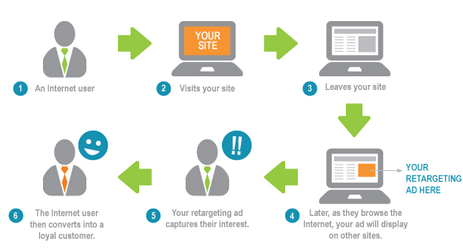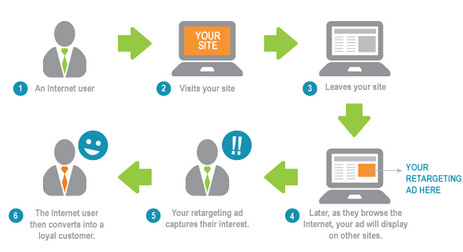
What’s the conversion rate of your shop? Around 2%? That’s more than likely, and it’s not a bad result. If you report higher rates, then good for you! However, if you report lower rates, maybe you should look into this issue.
What do you usually do to increase conversion rates? Focusing on improving the website is a reasonable place to start. When the website is easy to use and loads quickly, you can expect more people to buy. I won’t delve into the details here, but you can take a look at this guide if you want to know more about persuading people to buy more effectively.
There is another thing you can do to sell more to the same number of users – use retargeting. You can show ads across the internet to people who have already visited your website. It means that you can connect with those people who are already familiar with your brand and have probably seen some of your products. The infographic below shows exactly how retargeting works:

Sounds interesting, right? However, as you can imagine, there are different types of visitors. Some bounced off right after entering your site, while others added products worth hundreds of dollars to a cart. Showing every visitor the same set of ads is ineffective. So, how can you choose the right ads for the right groups of visitors? Read on, and I’ll show you 5 tricks you can use to make the most of your retargeting campaigns.
Ads showing products added to carts
Adding a product to a cart means that a person is likely to buy. Still, around 70% of people won’t complete the purchase. Building campaigns targeting them is a good first step in smart retargeting. It should be easier to convince them to buy the given product than any other group of potential customers. After all, adding a product to a cart means that a person probably likes it and accepts its price. Perhaps they simply didn’t have time to complete the order! Remind them what products they added to a cart and maybe even offer a time-limited discount to convert them into buyers.
Target people who already bought something
You probably send newsletters to people who have already bought something from you, but let’s be honest – people don’t like reading newsletters. Stats confirm it: the open rate for e-commerce newsletters is around 16%. However, people who bought something from you and are satisfied are more likely to buy than new visitors.
This is why creating retargeting campaigns for them can give good results. Just remember a few common mistakes, such as showing them ads immediately after they completed other orders. It’s better to wait a while and then show ads of other products that they might like. Also, don’t show them products that they just bought. Show them ads of products that are popular among a group of similar buyers or show them something new to draw their attention (recommendation engines might be of help in choosing the right products).
Show ads of similar products
Showing last viewed products is certainly more effective than showing basic ads of your shop. However, you can assume that at least some people viewed those products and did not buy for a certain reason. They might simply not like them or possibly find them too expensive. This is why showing ads or different products from similar categories might bring even better results.
Plus, you overcome the issue of privacy in this way. Some users might feel stalked if they only see ads of products that they viewed. Showing them different products will help solve this problem and give you an opportunity to introduce them to more interesting products that you sell.
Show ads for a different stage in the decision process
You won’t change the fact that some people are not willing to buy after visiting your store. They might be comparing your prices to those offered by the competition or simply considering what to buy. Some might be interested in buying from you, but need some time to save money.
Those people won’t come back to your shop and buy after seeing an ad of products that they viewed 10 minutes earlier.
What might help convert them into buyers are educational materials. If they’re still wondering what exactly to buy, they might like a guide to help them choose the right product in a given price range. After reading it, the person will be more likely to buy from you - just remember to establish strong calls to action.
The person who needs some time to save money will be more likely to convert if you show the ad at a more appropriate time, not right after the person leaves your website. The question is, how can you discover what stage they’re at in the decision process? That’s how we come to the last retargeting trick.
Use feedback to personalize ads
The last trick requires the usage of external tools. Here’s how it works: collect feedback from visitors on your website and build custom segments in Google Analytics based on them. Then, just create retargeting lists based on the segments. Let me show it in an example from the previous point.
Some people might be willing to buy something from you, but just not right now. It means that showing them ads immediately after they leave your shop won’t bring results and you will only annoy them. Therefore, finding this out would help you a lot. Essentially, you could wait until the right moment and show tailored ads. Or, if a person wants to buy now and compares you to the competition, you should jump in and possibly trigger a live chat or bid high when they leave your website to show them a special offer.
Using website survey tools integrated with Google Analytics will allow you to do just that with smart and unobtrusive widgets. You can find out more about using feedback to create personalized retargeting campaigns here.
Summary
As you can see, retargeting can be used in many clever ways to convert more visitors into buyers. Just remember one thing: people do get immune to ads. That’s why you should test different ad sets and not show them too often - probably 17-20 per month is enough. Using the described retargeting tricks doesn’t require much effort from you, but can bring significant results and give you a competitive edge.
This was a guest blog post from Lucjan Kierczak, an inbound marketer at Survicate (https://survicate.com/). Survicate is a tool that makes collecting feedback from website visitors easy and quick. You can follow him on twitter or LinkedIn.




Leave a reply or comment below